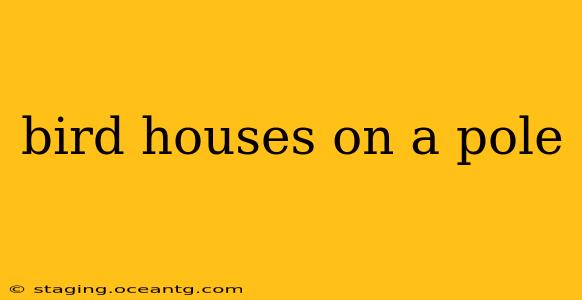Attracting birds to your garden is a rewarding experience, and mounting birdhouses on poles offers a unique and effective way to achieve this. This comprehensive guide delves into the specifics of designing, placing, and maintaining birdhouses on poles, helping you create a haven for feathered friends.
Why Choose a Pole-Mounted Birdhouse?
Pole-mounted birdhouses offer several advantages over those attached to trees or buildings. Firstly, they provide a safer haven from ground predators like cats and raccoons. Secondly, they offer better visibility and accessibility for birds, especially smaller species. Thirdly, they can be strategically positioned to maximize sunlight and minimize exposure to harsh weather conditions. Finally, they allow for easier cleaning and maintenance.
What Height Should a Birdhouse Pole Be?
H2: What height should I mount my birdhouse pole?
The ideal height depends on the bird species you wish to attract. Smaller birds, like chickadees and wrens, prefer lower heights, typically 4-6 feet. Larger birds, like bluebirds and woodpeckers, might prefer heights of 6-10 feet or even higher. Consider the surrounding vegetation; the birdhouse should be visible but also offer some protection from predators and harsh weather. Avoid placing the pole too close to obstructions that could impede bird flight.
What Type of Pole Should I Use?
The pole material should be durable, weather-resistant, and sturdy enough to support the birdhouse and withstand various weather conditions. Metal poles are a popular choice, offering longevity and resistance to rot and insect damage. However, treated wooden poles are also suitable, providing a more natural look. Ensure the pole is deeply embedded in the ground for stability.
What are the Best Birdhouses for Pole Mounting?
H2: What kind of birdhouse is best for a pole?
The best birdhouse for pole mounting will depend on the bird species you are targeting. Consider the size of the entrance hole, as this is crucial for attracting specific species. A well-ventilated birdhouse is also essential to prevent overheating and the build-up of moisture. Many commercially available birdhouses are specifically designed for pole mounting, featuring a pre-drilled hole for easy attachment.
How Do I Protect My Birdhouse from Predators?
H2: How can I protect my birdhouse from predators?
Protecting your birdhouse from predators is crucial for the birds' safety. Consider using predator guards, which are metal cones or baffles placed around the pole below the birdhouse. These prevent predators like squirrels, cats, and raccoons from climbing up the pole. Regularly inspect the pole and the birdhouse for any signs of damage or predator activity.
How Often Should I Clean My Birdhouse?
H2: How often should I clean a birdhouse on a pole?
Cleaning your birdhouse is essential for maintaining hygiene and preventing the spread of disease. It's recommended to clean the birdhouse at least once a year, ideally after the breeding season in the late fall or early winter. Remove any old nests, droppings, and debris. Use a gentle brush and warm water to clean the interior. Avoid harsh chemicals that could harm the birds.
What are some common mistakes to avoid when mounting a birdhouse on a pole?
H2: What are some common mistakes to avoid when putting up a birdhouse on a pole?
Common mistakes include using an unstable pole, placing the birdhouse in an unsuitable location, choosing a birdhouse that's too small or large for the target species, neglecting predator protection, and failing to clean the birdhouse regularly. Planning carefully and researching the specific needs of the birds you wish to attract will minimize these risks.
By following these guidelines and adapting them to your specific needs and location, you can successfully attract a variety of birds to your garden with pole-mounted birdhouses, creating a vibrant and thriving ecosystem. Remember, responsible birdhouse placement and maintenance contribute to the conservation and enjoyment of these beautiful creatures.
